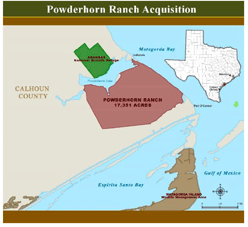In a chance meeting at the post office, I had a very nice chat with Dan Walker, TPWD Project Leader for the Coastal Bend Wetlands Ecosystem Project (Powderhorn WMA, Guadalupe Delta WMA, Matagorda Island WMA, Welder Flats WMA, Redhead Pond WMA). Dan was excited to share that the Wildlife Management Area portion of the ranch will officially become state property on October 1st. Dan was especially thrilled to report that he will be joined on the ranch by three new staff members. Jeremy Helms and Andy Gosnell have been hired as Technicians and Tori Haynes from Texas A&M Kingsville will be starting as the Wildlife Biologist.
You may recall that the Powderhorn was a working ranch for over 175 years. Starting in 2014, with settlement money from the Deepwater Horizon oil spill, the National Fish and Wildlife Foundation funded a significant portion of the $38.8 million for acquisition of the property in partnership with the Texas Parks and Wildlife Foundation, Texas Parks and Wildlife Department, The Nature Conservancy, and The Conservation Fund and grants from private foundations. The 17,351 acres property has since been managed by the Texas Parks and Wildlife Foundation with plans to donate the property to Texas Parks and Wildlife Department (the State) where 15,000 acres will be a wildlife management area (WMA) and the remaining ~3,000 acres a state park. I like to explain the difference between WMA and State Park as WMAs are managed for wildlife and State Parks are managed for people. It’ll be a while yet before the park portion opens but it’s significant progress that the Powderhorn WMA will be opening.
The Powderhorn WMA has five public hunts scheduled for this season: two youth deer hunts, 2 adult deer hunts, and one exotic hunt. Unfortunately, registration deadlines have already passed but be sure to go to the TPWD Public Hunts website next year to sign up. tpwd.texas.gov/huntwild/hunt/public Dan also expressed an interest in hosting some birding field trips on the WMA. The Powderhorn Ranch is an outstanding place to see wintering species and spring migrants. Look for more information on that soon. -Brigid Berger, Texas Master Naturalist

